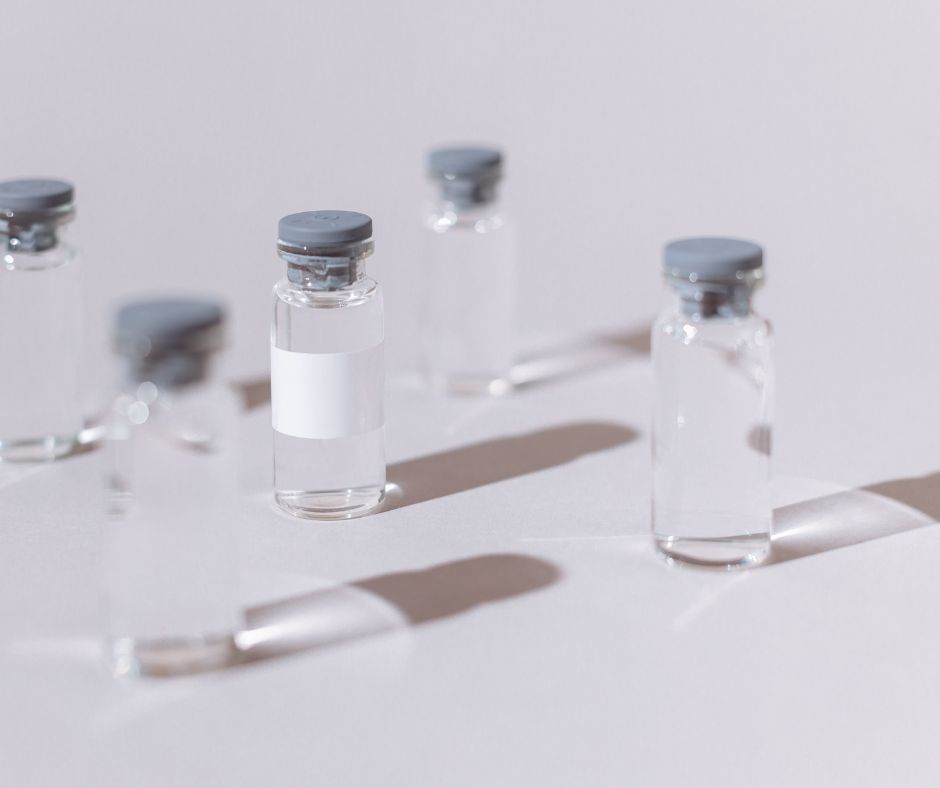Are you standing in front of the mirror, scrutinizing your skin, and wondering why, despite your best efforts, acne continues to be a persistent unwelcome guest?
Dealing with acne can feel like an uphill battle. But here’s where it gets interesting: not all acne is created equal.
If you’ve ever felt lost in the sea of acne treatments, knowing the type of acne you’re dealing with is the first step towards clear, healthy skin. Learn here how to tell if acne is hormonal or bacterial and start getting rid of acne today.
Acne Decoded: What’s Happening Under Your Skin?
Acne: it’s a word that can bring a collective sigh from anyone who’s ever dealt with a breakout. But to tackle it effectively, we need to start at the beginning and understand what acne really is and why it happens.
Acne fundamentally is a condition affecting the skin, resulting from hair follicles getting blocked with oil and dead skin cells. This leads to the development of various types of blemishes, including:
- Pimples
- Blackheads
- Whiteheads
While it’s most common among teenagers going through puberty, adults are far from immune.
Several factors contribute to acne, including:
- Genetics
- Diet
- Stress
- Hormone changes
- The presence of certain types of bacteria on the skin
Hormones can increase oil production, diet can influence inflammation, and stress can affect your body’s natural balance, all leading to the two different types of acne.
Within the acne universe, two main villains stand out: hormonal and bacterial acne. Hormonal acne is often tied to the internal fluctuations of your body’s hormones. It’s a direct response to changes within, such as puberty, menstrual cycles, or stress, affecting oil production and skin cell turnover.
Bacterial acne, on the other hand, is the result of external factors allowing bacteria to thrive on the skin, leading to inflammation and those all-too-familiar breakouts.
Identifying the root causes of acne is like having the right key for a lock. It guides you to the most effective treatment strategies.
Hormonal acne may require systemic treatments that address internal imbalances, such as prescription medications or hormonal therapy. Bacterial acne might be best tackled with topical treatments that target the bacteria and reduce inflammation.
Recognizing which type of acne you’re dealing with enables you to choose the right tools to clear your skin.
The Culprits Behind Your Acne: Hormonal vs. Bacterial
Hormonal acne isn’t just about the obvious ups and downs of hormones. In fact, it’s more about how those fluctuations affect your skin on a cellular level.
When hormone levels rise, they boost sebum production. However, it’s the quality of sebum that changes too, becoming more prone to clogging pores. Additionally, hormonal shifts can increase skin inflammation and affect the rate at which your skin cells regenerate and shed, all of which combine to create the perfect storm for acne.
For women, cycles of menstruation, pregnancy, and menopause are significant triggers. During these times, the balance between estrogen and progesterone shifts, often increasing the production of androgens. These male hormones boost oil production, leading to clogged pores and breakouts.
Conditions like Polycystic Ovary Syndrome (PCOS) exacerbate this effect by further elevating androgen levels.
Though less discussed, men are not immune to hormonal acne. Testosterone levels can fluctuate due to stress, diet, and other health conditions, contributing to increased oil production and acne.
Cortisol, the stress hormone, plays a crucial role for both men and women. Elevated cortisol levels can stimulate oil glands, leading to more acne. It’s a reminder of how closely our skin’s health is tied to our emotional and physical well-being.
Beyond the typical times of hormonal fluctuation, factors like diet and certain medications can also impact your hormonal balance. For example, high glycemic foods and dairy can lead to changes in hormone levels that might exacerbate acne.
Bacterial Acne: A Closer Look
While it’s true that bacterial acne stems from the proliferation of bacteria, the full picture involves how these bacteria interact with your skin’s environment.
P. acnes bacteria, which are often involved in acne, thrive in oily, low-oxygen environments. When your pores are clogged with excess sebum and dead skin cells, it creates the perfect breeding ground for these bacteria, leading to inflammation and acne.
Everyone has bacteria on their skin. But what encourages these bacteria to overgrow and create acne? Factors like:
- Humidity
- Improper skincare
- Leaving makeup on for too long
- Even certain types of skincare products
They can all contribute to creating an environment where harmful bacteria can thrive.
With this understanding, you can start to see why simply washing your face more often isn’t enough to combat acne, and why treatments need to be tailored to the type of acne you’re dealing with. Whether it’s hormonal or bacterial, understanding the root cause gives you a fighting chance to clear your skin with the right strategy.
Signs and Signals: Reading Your Acne’s Language
By paying attention to the clear signs and patterns, you can start to piece together whether your acne is more likely hormonal or bacterial. This knowledge is power, leading you toward the most effective treatments and closer to clearer skin.
Physical Characteristics
Hormonal acne often presents as deep, cystic bumps. These are the blemishes that feel like they have a deeper root, often painful and tender to the touch.
They don’t always come to a head the way other pimples might and can take longer to heal. The skin around these blemishes might also feel more sensitive due to the underlying inflammation.
Bacterial acne, in contrast, tends to show up as surface-level blemishes, including whiteheads and blackheads, as well as pustules that are red and inflamed with a white center. These pimples are more about what’s happening on the skin’s surface and can vary in size and severity.
Common Areas
Hormonal acne typically stakes its claim on the lower part of your face, especially around the jawline and chin. It’s not uncommon for hormonal acne to also appear on the neck or even along the shoulders and back, areas that are sensitive to hormonal changes.
Bacterial acne doesn’t play favorites with location. It can pop up anywhere there’s skin. However, it’s frequently found in areas where oil production is high, such as the T-zone (forehead, nose, and chin), and can also affect the back and chest.
Flare-Up Timings
The timing of hormonal acne flare-ups is a big clue. They often align with the menstrual cycle in women, appearing in the days leading up to a period. Stress is also a significant trigger, so if you notice breakouts during or after stressful periods, it might be hormonal.
Bacterial acne doesn’t follow a predictable schedule the way hormonal acne does. Instead, flare-ups might be linked to external factors, like changes in:
- Skincare routines
- Climate
- After wearing heavy makeup or sweating more than usual without proper cleansing
Treating Your Acne: Tailored Strategies for Success
Clearing up acne is a personal journey that doesn’t come with a one-size-fits-all solution. Whether your acne is hormonal or bacterial, knowing the difference can lead you down the right path to clearer skin.
Tackling Hormonal Acne
If hormonal changes are at the root of your acne, your best bet might be to consult with a dermatologist. They can offer treatments that balance your hormones, potentially including medications or even lifestyle changes that can help.
For the skin’s surface, topical retinoids are a go-to. They help by speeding up skin renewal and preventing those pesky pores from getting clogged.
Adjusting your lifestyle can also play a big role. Think about reducing stress and tweaking your diet to avoid foods that might spike your blood sugar and, in turn, your hormone levels. It’s all about finding balance, both inside and out.
Handling Bacterial Acne
For bacterial acne, the strategy shifts towards keeping those unwanted bacteria in check.
Topical treatments like benzoyl peroxide are great for killing bacteria and reducing inflammation. Regular, gentle exfoliation helps too, by removing dead skin cells that can clog pores.
Also, take a good look at your skincare routine. It’s important to keep your skin clean, but overwashing can actually backfire by drying out your skin and prompting it to produce even more oil.
Good Practices for Any Acne Type
Drinking plenty of water and using sunscreen are basic but powerful ways to support your skin’s health. And as tempting as it might be, try not to pick at your pimples.
Patience is key. Acne treatments can take a while to work, sometimes up to several weeks, so give them time to do their magic.
And if something isn’t working, don’t be afraid to switch it up. Skincare is personal, and what works for someone else might not work for you.
How to Tell if Acne Is Hormonal or Bacterial?
Knowing how to tell if acne is hormonal or bacterial is crucial in crafting an effective treatment plan tailored to your specific needs. Armed with this insight, you’re well on your way to achieving the clear skin you deserve.
At Evolve, we’re passionate about empowering you to live a happier, healthier life. We’re dedicated to helping you understand your acne, whether it’s hormonal or bacterial, and finding the perfect treatment strategy for you.
If you’re ready to treating your acne with a team that truly cares, book an appointment with Evolve today.






